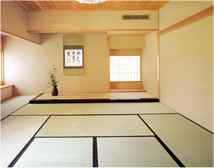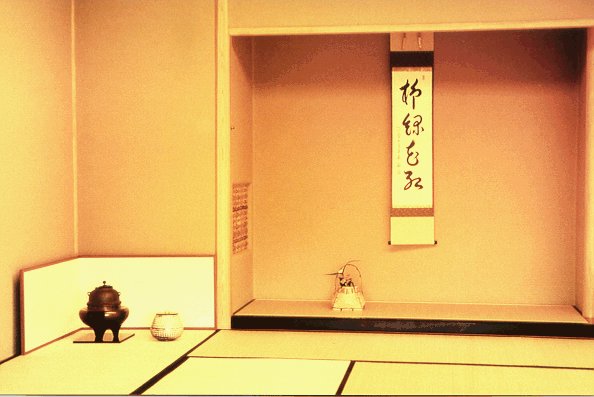Tatami, Japan's traditional flooring
 |
Tatami refers to a
type of flooring common to the traditional Japanese home. When
the people of ancient Japan lived in primitive dwellings with
earthen floors, the custom of covering floors with straw, husks,
or other plant fibers developed. Later, these fibers were woven
together to form a mat, called tatami. These first forms of
tatami were used exclusively by the privileged classes - the
nobility, the clergy, and the samurai - and assumed the
functions of chair, cushion, bed, and stool. In the 15th century, samurai began completely covering floors with tatami; it would take another three centuries for this custom to be adopted by the common person. |
 |
The making of tatami
is intricate and requires years of study. The first step is the
making of the main body, or toko, from wara - the stalks of rice
plants after the rice has been harvested. The rice stalks are
placed in a stack measuring approximately thirty centimeters and
compressed to about one-fifth the thickness. Today, tatami artisans are having to import rice stalks from Korea, China, and Taiwan, since an adequate supply cannot be had in Japan. |
For the second step, a thin mat made from the woven stems of rush plants,
chosen for their fresh smell and greenery, is stretched tightly over and
sewn to the toko to create the tatami facing. Finally, the tatami
artisan attaches the heri to the length of the tatami. The heri is a
piece of cloth sewn along the sides to prevent the tatami from
unraveling While a highly skilled tatami artisan can complete the second
and final step in one hour, modern machinery can finish these two steps
in about ten minutes.
The tatami artisan visits the home to determine the size and number of
tatami needed for a room - the tatami must fit the floor of the room
perfectly and snugly, like the pieces of a jigsaw puzzle. The tatami
artisan sets the completed tatami mats into the floor, with only the
facings visible. Because the green stems of the rush plants turn a straw
yellow with time, in the past, it was common for the tatami artisan to
again visit the home a year later to turn over the facing so that the
under side of the mat would face up. Another year would go by, after
which, the tatami facing would be completely replaced with a fresh set.
This custom is rarely practiced - and even unknown - today, as many
young Japanese have begun covering tatami with carpeting to create a
Western look.
Over the years, tatami have been ranked according to the quality of the
materials and the craftsmanship. However, increased urbanization, and
the demand for reasonably-priced housing, have stimulated the need for
lower cost tatami. Cheaper materials such as Styro-foam have been
substituted in the toko; heri made from synthetic fibers have also
become quite common.
A second effect of urbanization has been on the size of tatami. Usually,
the tatami's length is two times the width, about 180 by 90 cm. In
Japan, since room sizes are often compared by the number of tatami it
takes to cover the floor - for example, a six-mat room - people have a
general image of how big a six-mat room should be. However, the high
concentration of people in the cities has resulted in smaller housing
units. Tatami sizes were reduced to between 70 and 80 cm. in width, in
order to maintain the illusion of standard room size. These smaller
tatami are referred to as danchi-size and are quite common in modern
housing. Young Japanese feel this reduction keenly, since their average
height has considerably increased over the years.
Tatami have a long history and are closely identified with Japanese
culture. However, like many traditions they have had to struggle against
the tide of modern progress: The number of tatami artisans has declined,
while western-style flooring has grown in popularity; because most
tatami are made by machines, few are trained in traditional handmade
tatami making. In spite of this, tatami are enjoying greater popularity
both at home and abroad (Asian countries, in particular). Deep down,
Japanese know - what others are just finding out - there is no
substitute for the fresh smell of tatami or the unique atmosphere these
mats create.

